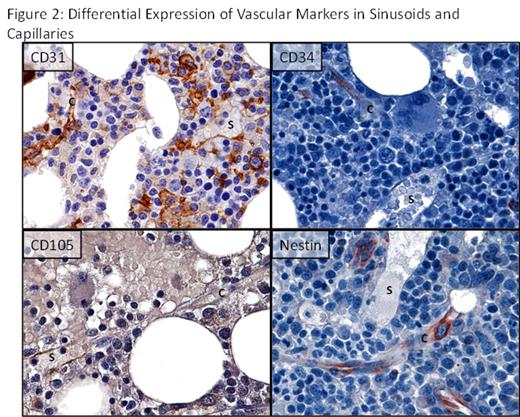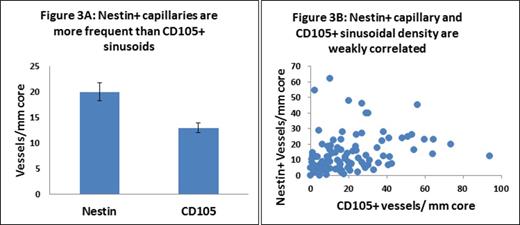Abstract
Introduction
The vascular compartment of bone marrow encompasses a complex network of different types of vessels which serve various functions providing support, nutrient supply, and modes of egress for the developing hematopoietic elements. One of the most abundant vessels in this network is the bone marrow sinusoid, which serves as the site of megakaryopoiesis and exit for mature elements to the bloodstream. Marrow capillaries are surrounded by maturing myeloid precursors. Previous work in mouse models have shown that murine sinusoids specifically express vascular endothelial growth factor receptor 3 (VEGFR3) and that the bone marrow vasculature is critical for bone marrow engraftment following stem cell transplantation (Hooper et al. Cell Stem Cell. 2009 Mar 6;4(3):263-74). In this study, we sought to further characterize the human bone marrow sinusoid in the context of normal marrow and in marrow from patients with myelodysplastic syndromes (MDS).
Methods
Tissue microarrays were constructed from formalin fixed paraffin embedded rapidly decalcified bone marrow biopsies from patients with myelodysplastic syndromes (101 cores) and healthy controls (52 cores). Sections were cut and stained with several vascular markers: CD31, CD34, CD105, nestin, and VEGFR3. Sinusoids were morphologically defined as thin-walled, serpiginous and often gaping vessels often containing RBC’s and/or hematopoietic elements; capillaries were defined as round vessels with a visible pericyte layer and a lumen the size of an RBC or less; and arterioles as round vessels with a smooth muscle layer and lumina the size of two RBCs or more. Vessels were evaluated in duplicate on a semi-quantitative scale for extent and intensity of staining.
Results
The classic vascular markers CD31 and CD34 as well as nestin showed a predominantly capillary pattern of staining, whereas CD105 was predominantly sinusoidal in distribution (Figures 1 and 2). Capillaries showed significantly stronger staining for CD31 (χ2 = 126.9, p<0.0001), CD34 (χ2 = 112.1, p<0.0001), and nestin (χ2 = 193.5, p<0.0001) than sinusoids. Arterioles showed a similar staining pattern to capillaries. Conversely, sinusoids showed significantly stronger staining for CD105 (χ2 = 134.7, p<0.0001) than capillaries. Of the three capillary-staining markers, nestin was the most specific for capillaries as compared to sinusoids; we therefore enumerated of CD105+ and nestin+ blood vessels to assess the relative density of these vessel types (Figure 3). Nestin+ vessels are more numerous than CD105+ vessels on average (Mann-Whitney independent samples test, p=0.0029) and the density of the two types of vessels within a given core differed significantly (Wilcoxon test paired samples test, p=0.0004). This was reflected in the weak but statistically significant positive correlation between CD105+ and nestin+ vessel density (Spearman rank correlation co: rho=0.359, p=0.0002). VEGFR3 showed rare weak staining in sinusoids but was predominantly lacking and was negative in arterioles and capillaries. Vascular marker expression patterns in marrow samples from patients with myelodysplastic syndromes were not significantly different than those in healthy controls.
Conclusions
CD105 (endoglin) is the most sensitive marker thus for bone marrow sinusoids in intact human bone marrow core biopsies.
Different bone marrow vessel types show different expression profiles with sinusoids showing a CD105 (strong), CD31 (weak), CD34(weak), nestin (weak) profile in comparison to capillaries and arterioles, which show a CD105 (weak), CD31 (strong), CD34 (strong), nestin (strong) profile.
There is no significant difference in the expression of tested markers on either sinusoids or capillaries in patients with myelodysplastic syndromes as compared to healthy controls.
No relevant conflicts of interest to declare.
Author notes
Asterisk with author names denotes non-ASH members.




This feature is available to Subscribers Only
Sign In or Create an Account Close Modal